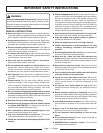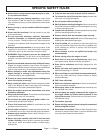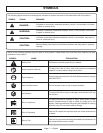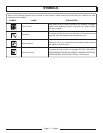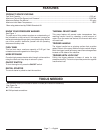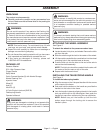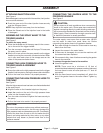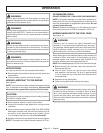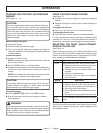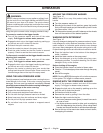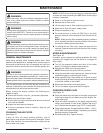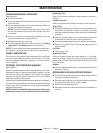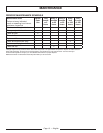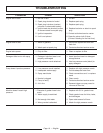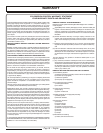
Page 11 — English
OPERATION
STARTING AND STOPPING THE PRESSURE
WASHER
See Figures 11 - 12.
CAUTION:
Do not run the pressure washer pump without water sup-
ply connected and turned on, as this may damage the
high pressure seals and decrease pump life. Completely
unwind the hose from its reel or coil and make sure the
hose is not being restricted by tires, rocks, or any other
objects that may lessen or prevent water flow to the
pressure washer.
Before starting the engine:
Connect all hoses.
Check all fluids (lubricant and gas).
Turn on the garden hose then squeeze the trigger to
relieve air pressure; hold the trigger until a steady stream
of water appears.
To start the engine:
Push primer bulb 3 times.
NOTE: If starting the engine for the first time, push the
primer bulb 5 times.
Put the ON/OFF switch in the ON position.
Grasp the recoil starter and pull slowly until resistance is
felt. Give the recoil starter a short, brisk pull to start the
engine.
NOTE: Do not allow the recoil starter to snap back after
starting; return it gently to its original place.
CAUTION:
If the engine does not start after each pull of the recoil
starter, squeeze the trigger to relieve water pressure
before attempting to start the engine again.
To stop the engine:
Put the ON/OFF (I/O) switch in the OFF position.
Shut off the water supply and pull trigger to release
water pressure.
WARNING:
Hold the handle and wand securely with both hands. Ex-
pect the trigger handle to move when the trigger is pulled
due to reaction forces. Failure to do so could cause loss
of control and injury to yourself and others.
USING THE SPRAY WAND TRIGGER
See Figure 13.
Pull back and hold the trigger to operate the pressure
washer.
Release the trigger to stop the flow of water through the
nozzle.
To engage the lock out:
Push up on the lock out until it clicks into the slot.
To disengage the lock out:
Push the lock out down and into its original position.
For the most effective cleaning, the spray nozzle should be
between 8 in. and 24 in. from the surface to be cleaned. If
the spray is too close it can damage the cleaning surface.
SELECTING THE RIGHT QUICK-CONNECT
NOZZLE FOR THE JOB
See Figure 14.
Before starting any cleaning job, determine the best nozzle
for the job. Each of the three nozzles has a different spray
pattern. The nozzle patterns are: 0˚ (high pressure), 25˚ (me-
dium pressure), and detergent (low pressure).
Nozzle Application
0º Red Spot cleaning of high, hard-to-reach areas
• Removing caked-on mud from heavy con-
struction, farm, or lawn equipment
• Cleaning tar, glue, or stubborn stains from
concrete
• Cleaning overhead areas
• Removing rust from steel and oxidation
from aluminum
Nozzle Application
25º Green For general purpose or large surfaces
• General cleaning of dirt, mud, and grime
• Cleaning roofs, gutters, and downspouts
• Removing light mildew stains
• Removing algae and bacteria build-up from
pools
• Rinsing surfaces in preparation for painting
Soap
(Black)
For all detergent applications and for gentle
rinse
NOTE: For a gentle rinse, select the detergent nozzle.
Scouring the surface requires a more direct spray of water.
Select the 0˚ nozzle for tough jobs. Apply detergent using
the detergent nozzle.



